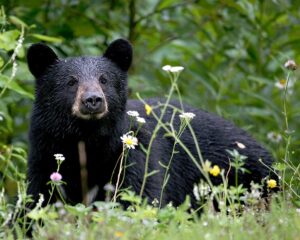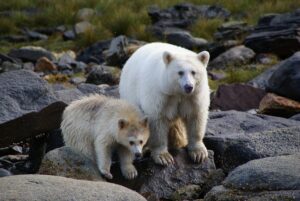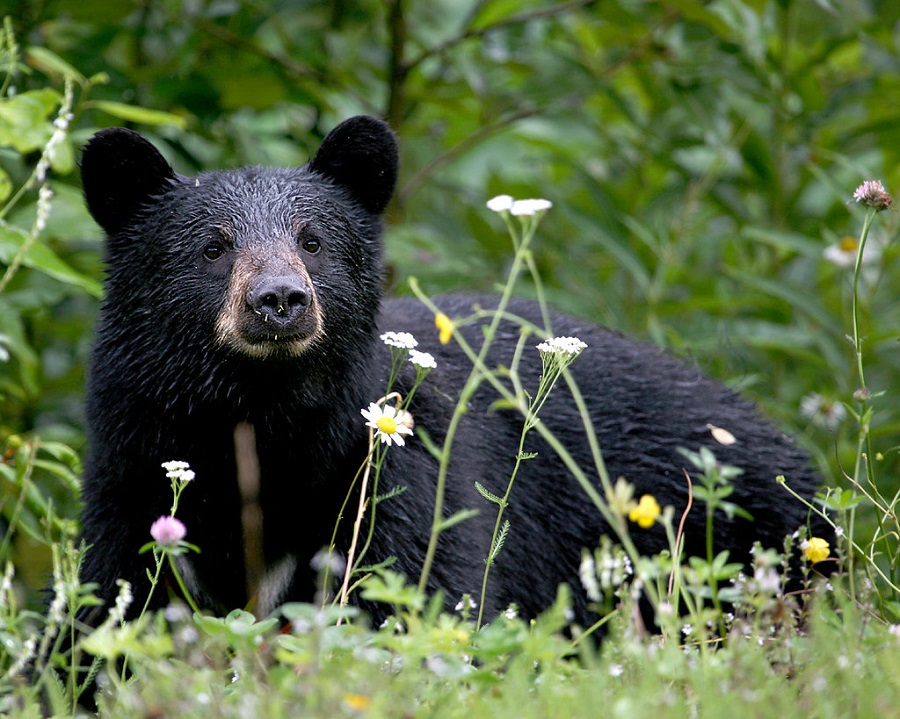American Black Bear Introduction
Ursus Americanus (American Bear) is a medium-sized bear native to North America and is the continent’s most numerous bear species. Despite the name, some subspecies can be brown in coloration, not to be confused with the Brown bear.
American Black bears are not closely related to the brown bear or the polar bear but both they and the Asiatic Black bear are more closely related to Sun bears. Although a similar species, the ancestors of American black bears diverged from their Asiatic cousins around 4 million years ago so they are actually quite different. For context, brown bears and polar bears diverged from each other only 500,000 years ago.
American Black Bear Speed
Black bears can run at a speed of 25-30mph (40-50km/h) but they cannot keep this pace up for long and they are much more likely to be ambling along slowly.
American Black Bear Size
American black bears vary considerably in size depending on whether they are male or female, where they live, and the time of year. In California, the average size for a male black bear was found to be 86Kg with females averaging just 58Kg. In Kulu island in Alaska, where salmon are plentiful, the average adult weight was 115Kg. These sizes can vary about 30% during the year with the bears being heavier before they hibernate. The largest black bear ever recorded lived in New Brunswick, Canada, and was 500Kg when it was shot.
American Black Bear Habitat
American black bears are very adaptable and can be found in various forest locations such as humid woodlands, Flatwoods, bays, and swampy hardwood sites in South Eastern USA, coniferous Canadian forests, and dry Mexican woodland. They prefer areas away from human habitation but have adapted well to semi-urban areas and are a fairly common sight in some gardens. In North-Eastern Canada they also extend to areas without plant cover that are more synonymous with brown bears or polar bears.
Their range extends across the whole of North America with the exception of the central plains of the USA. In Canada, they inhabit much of their original range and their numbers are around 425,000. In the US, their range is a bit more fragmented but they still number around 420,000 and this excludes Alaska where it is impossible to determine what the population is. In Mexico, the population is more fragmented still and they are endangered in that country.

American Black Bear Diet
American black bears have an incredibly varied diet but insects and plants make up most of their food intake with 85% of their diet being vegetarian. They eat tree bark, grass, roots, honey, nuts such as hazelnuts, acorns, and pine nuts, fruits such as apples, cherries, strawberries, blueberries, raspberries, and cranberries. They also eat fish, mice, rabbits, carrion, and occasionally deer fawns and moose calves. The majority of their animal intake is insects, however, with bees, wasps, ants, and their larvae being particularly popular. Bears living near human habitation have also learned to eat trash, birdseed, and honey.
The bears living near the coast will also eat fish such as salmon and trout but they fish for these at night as their black fur is very conspicuous. Black bears very rarely hunt adult large mammals but there have been isolated reports of them attacking deer and even elk, preferring injured animals as they are not particularly adept at chasing them for long distances.
American Black Bear Adaptations
There are a number of adaptations that allow black bears to have such a varied diet. They have strong, curved claws which allow them to easily climb trees in search of fruit, nuts, and honey and their long sticky tongue is perfect for eating insects such as ants. Their flat molars are great for chewing plants and their sharp canine teeth are perfect for tearing open tree bark or carrion. Additionally, they have a decent color vision which helps with the identification of berries.
American Black Bear Hibernation
American black bears do hibernate and they are considered very efficient hibernators. Their body temperature does not drop but their metabolic rate can drop to a quarter of what it was prior to hibernation and their heart rate drops from 40 to 50 beats per minute to 8 beats per minute. They usually enter hibernation in October and November and will often create their own dens in which to hibernate. Pregnant females will give birth to their cubs in these dens around February time.
Not all American black bears hibernate, however. Those in the Southern part of their range such as Mexico and Florida do not hibernate unless they are pregnant mothers or they have yearling cubs.
American Black Bear Reproduction
The mating period for black bears is between June to August and the gestation period is 235 with most cubs being born around February. The fertilized eggs do not implant onto the mother’s womb until November as they undergo delayed development.
The cubs are born blind but they do have fine hair. They weigh between 250g and 500g at birth and open their eyes for the first time after around 35 days, and start to walk at about 5 weeks. They are dependent on their mother’s milk for about 7 months and gain independence totally after around 16 to 18 months.
Is the American Black Bear Endangered?
The American black bear is the most numerous bear with a population of over one million individuals. This means that they are considered as Least Concern on the IUCN Red List. Despite hunting and encounters with humans, the population in much of North America is actually increasing. Black bears are not very aggressive and generally tolerant of humans so there tend to be fewer detrimental encounters. That is not to say we should not be wary. Some populations such as the ones in Mexico and Florida are considered endangered and they still face threats due to hunting, road building, or habitat loss.

American Black Bear Predators
Black bears have very few natural predators. By far the biggest threat is humans. Aside from this, however, black bear cubs can be killed by wolves or mountain lions. Black bears tend to be out-competed by both wolves and brown bears over kills and these confrontations can occasionally be fatal for the black bear. The black bear is an adept climber of trees, however, so they can usually escape if they don’t stray too far from their forest habitat. There have been some anecdotal reports of black bears being taken by alligators but there does not seem to be any proof of this.
American Black Bear Sub-Species
There are a number of American black bear subspecies and they are, in no particular order:
- Californian Black Bear
- New Mexico Black Bear
- Eastern Black Bear
- East Mexican Black Bear
- West Mexican Black Bear
- Olympic Black Bear
- Cinnamon Bear
- Newfoundland Black Bear
- Florida Black Bear
- Glacier Black Bear
- Queen Charlotte Islands Black Bear
- Louisiana Black Bear
- Spirit Bear
- Vancouver Island Black Bear
- Kenai Black Bear
- Dall Island Black Bear.
Two of these subspecies I think are particularly special so let’s learn a bit more about the Cinnamon Bear and the Spirit Bear:
Cinnamon Bear
The first thing you will notice about the Cinnamon Bear is its striking red-brown fur, much like cinnamon. They have established populations in Colorado, New Mexico, Utah, Idaho, Nevada, Washington, California, Minnesota, Wisconsin, Wyoming, and Alberta, Ontario, British Colombia and Manitoba in Canada. They are strong swimmers and climbers and are mostly nocturnal.
Spirit Bear
Otherwise known as the Kermode Bear, the Spirit Bear only lives in the Central and North Coast regions of British Colombia in Canada. While most Kermode bears are black, between 100 and 500 individuals have fully white fur and these are known as Spirit Bears. Unsurprisingly these striking bears have a special meaning to the indigenous populations of the area. You are most likely to find Spirit bears on Princess Royal, Roderick, and Gribbell Islands where they make up around 15% of the Kermode bear population.
Interestingly, because salmon know to avoid large, black shapes the Spirit bears are 35% more successful in hunting salmon during the day and studies have shown that salmon make up more of the Spirit bear’s diet than other Kermode black bears.
The bear’s habitat was briefly threatened by the proposed Enbridge Northern Gateway pipelines but they were opposed by the indigenous groups who lived there and the pipeline was thankfully rejected by the federal government.
Kermode bears are not particularly rare but they are vulnerable to habit loss from oil pipelines, trophy hunting and they are dependent on the health of the salmon stock. Due to their cultural significance to the indigenous populations, considerable efforts are being made to protect the habitat of these bears.

Are American Black Bears Dangerous?
The answer to this is surprising, not really. American black bears are powerful animals with sharp teeth and claws but they are actually quite timid. Despite being by far the most numerous bear species in the world, American black bears on average kill less than one person a year. That is not to say they do not sometimes attack people, they do, but those attacks are rarely fatal.
The most common violent interaction is if a black bear is startled, it might swipe at a person but this is unlikely to cause long-lasting damage. In contrast to brown bears, where most of the fatal attacks are from bears defending themselves or their cubs, the rare fatal black bear attacks are usually predatory in nature from hungry bears not used to human contact. One exception to this is when the bears get into confrontations with dogs and the owners intervene.
Due to this, the technique for handling a black bear attack is completely different from that of a brown bear encounter. As with brown bears, do not turn and run but make as much noise as possible, trying to scare the bear away. As the attacks are usually predatory, you have a better chance of surviving by fighting back. Another big difference between black bears and brown bears is that a brown bear mother with cubs can be dangerous as she is fiercely protective over them, but this is not the case with black bears.
For more information about what to do in the case of a brown bear encounter, have a look at our article about brown bears here.
I would like to reiterate, however, that the vast majority of encounters with American black bears are non-violent. If you give the bear space – don’t startle it or try and touch it, you can have a very rewarding encounter observing the bears.
FAQs
What do American black bears Eat?
Almost anything! They like grass, roots, fruit, berries, insects, carrion, honey, trash, there is not much they won’t eat.
What eats American Black Bears?
Nothing really predates American black bears apart from humans. Wolves may rarely kill bears and cougars may take cubs.
Are black bears dangerous to humans?
Not really, less than one person a year is killed by black bears in North America which considering there are over one million black bears in the wild is a tiny number.
Do black bears kill deer?
They can but it is rare. They may ambush weak or injured deer or take fowls.
Can a black bear swim?
Yes, black bears are excellent swimmers and climbers. They can enter the water in search of fish and cubs can swim from an early age. Indeed, one black bear was seen swimming 9 miles from shore in the Gulf of Mexico!
When are black bears most active?
Generally, they become active just before dawn, have a few naps during the day, become more active again at dusk, and sleep overnight but this depends somewhat on the population and sub species as some are more active at night, likely to avoid people or other bears.
What mammals do black bears eat?
They will eat rodents and any carrion they find and some black bears are able to hunt deer and other hoofed animals, although usually only young or injured prey. They may also rarely eat domesticated animals such as sheep.
How long does a black bear live?
In the wild black bears live to around 18 years on average, although the record in captivity is a black bear that lived to be 44 years old.

